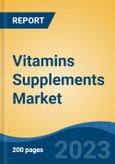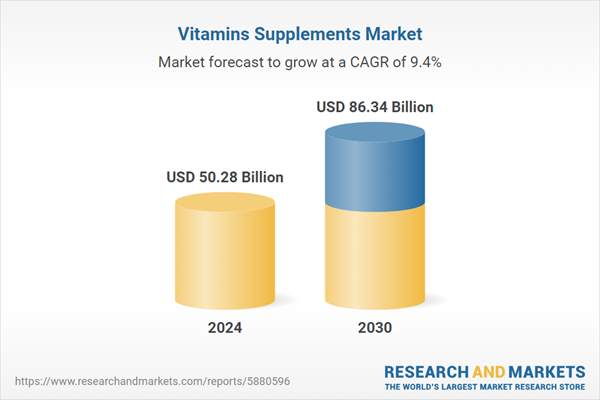Speak directly to the analyst to clarify any post sales queries you may have.
10% Free customizationThis report comes with 10% free customization, enabling you to add data that meets your specific business needs.
Due to hectic schedules, many individuals struggle to maintain a balanced diet, resulting in nutrient deficiencies. Consequently, there has been a significant rise in the consumption of vitamin supplements to fulfill daily nutrient and vitamin requirements, promoting overall health and vitality. Furthermore, the increasing healthcare expenditure worldwide is anticipated to drive the demand for vitamin supplements. Additionally, the growing elderly population in both developed and developing economies presents lucrative opportunities for market players in the forecast period. The senior population, in particular, relies on vitamin supplements to meet their dietary needs, promote bone health, and support overall well-being.
Key Market Drivers
Rise in The Demand for Functional And Nutritionally Enriched Processed Food Products
Consumers are becoming more health-conscious and are actively seeking foods that can support their overall well-being. This has led to a shift in focus from mere caloric intake to the nutritional quality of foods. Consumers with specific dietary preferences (e.g., vegetarian, vegan) or restrictions (e.g., gluten-free, lactose-free) are seeking processed foods that not only meet these requirements but also offer added nutritional benefits. Consumers are looking for convenient options that fit into their busy schedules without compromising on nutrition. Functional foods that provide quick and balanced nutrition are gaining popularity. Brands are increasingly highlighting the nutritional benefits of their products on labels.Claims like "high in fiber," "rich in antioxidants," or "good source of vitamins" attract health-conscious consumers. Consumers have easy access to nutritional information and research, which empowers them to make informed choices about the foods they consume. According to the Council for Responsible Nutrition's 2023 survey, 74% of U.S. adults use supplements regularly, with 92% viewing them as essential for health. Europe ranks as the third-largest market, with an emphasis on scientific validation and regulatory compliance for health claims.
Key Market Challenges
Consumer Mistrust Resulting from Deceptive Marketing Practices Poses a Significant Obstacle To Market Expansion
Manufacturers and marketing agencies employ a wide range of advertising strategies to boost the sales of vitamins supplements. Unfortunately, some of these strategies involve making false claims about the effectiveness of these supplements, luring unsuspecting customers with promises of fast and superior results. Consequently, first-time buyers are often left disappointed when these products fail to deliver as promised.Deceptive marketing may involve making unsubstantiated claims about the benefits of vitamin supplements that lack scientific evidence. Consumers who purchase supplements based on such claims may feel misled and dissatisfied if the promised results are not achieved. Deceptive marketing might withhold or obscure important information about potential risks or interactions associated with vitamin supplements. This lack of transparency can lead to distrust. The dietary supplement industry is regulated differently from pharmaceuticals, and this can create opportunities for unscrupulous marketers to make false or exaggerated claims without facing the same level of scrutiny.
While the number of misleading advertisements is relatively small compared to genuine ones, these instances have eroded consumer trust in the efficacy and value of vitamins supplements. This challenge significantly hampers the adoption and usage of such supplements by new customers, ultimately impacting market growth in the forecast period.
Key Market Trends
Increasing Demand for Personalized Supplement
The increasing demand for personalized supplement solutions is an emerging trend in the vitamins supplements market. A growing number of online retailers and manufacturers are providing consumers with access to personalization tools and platforms. These tools allow consumers to create a specialized supplement list tailored to their nutritional requirements, health conditions, and preferences. By collecting data on a consumer's supplement regime, sleep patterns, and daily activities, these online tools can make recommendations based on specific needs. This will cater to the growing consumer needs by providing individuals with customized nutrient information based on their health requirements.In recent years, several new players have entered the market, offered subscription-based customized supplement plans and delivering dietary products directly to customers. It is expected that more such businesses will emerge in the coming years. These factors are anticipated to drive the growth of the global vitamins & vitamins supplements market during the forecast period.
Key Market Players
- Glanbia Plc
- Pfizer Inc.
- Bayer AG
- Amway Corp.
- GlaxoSmithKline plc.
- Good Health New Zealand
- The Nature's Bounty Co.
- NOW Foods
- Abbott
- Herbalife Nutrition
Report Scope:
In this report, the Global Vitamins Supplements Market has been segmented into the following categories, in addition to the industry trends which have also been detailed below:Vitamins Supplements Market, By Type:
- Vitamin B
- Vitamin E
- Vitamin D
- Vitamin C
- Vitamin A
- Vitamin K
Vitamins Supplements Market, By Application:
- Healthcare products
- Pharmaceuticals
- Food and beverages
- Animal Feed
- Personal care
Vitamins Supplements Market, By Source:
- Synthetic
- Natural
- Plant
- Animal
- Others
Vitamins Supplements Market, By Form:
- Powder
- Tablets
- Capsules
- Soft gels
- Gummies
Vitamins Supplements Market, By Distribution Channel:
- Hospital Pharmacies
- Retail Pharmacies
- E-stores
- Hypermarkets/supermarkets
Vitamins Supplements Market, By Region:
- North America
- United States
- Canada
- Mexico
- Europe
- France
- United Kingdom
- Italy
- Germany
- Spain
- Asia-Pacific
- China
- India
- Japan
- Australia
- South Korea
- South America
- Brazil
- Argentina
- Colombia
- Middle East & Africa
- South Africa
- Saudi Arabia
- UAE
Competitive Landscape
Company Profiles: Detailed analysis of the major companies present in the Global Vitamins Supplements Market.Available Customizations:
With the given market data, the publisher offers customizations according to a company's specific needs. The following customization options are available for the report.Company Information
- Detailed analysis and profiling of additional market players (up to five).
Table of Contents
Companies Mentioned
- Glanbia Plc
- Pfizer Inc.
- Bayer AG
- Amway Corp.
- GlaxoSmithKline plc.
- Good Health New Zealand
- The Nature's Bounty Co.
- NOW Foods
- Abbott
- Herbalife Nutrition
Table Information
| Report Attribute | Details |
|---|---|
| No. of Pages | 180 |
| Published | August 2025 |
| Forecast Period | 2024 - 2030 |
| Estimated Market Value ( USD | $ 50.28 Billion |
| Forecasted Market Value ( USD | $ 86.34 Billion |
| Compound Annual Growth Rate | 9.4% |
| Regions Covered | Global |
| No. of Companies Mentioned | 10 |









